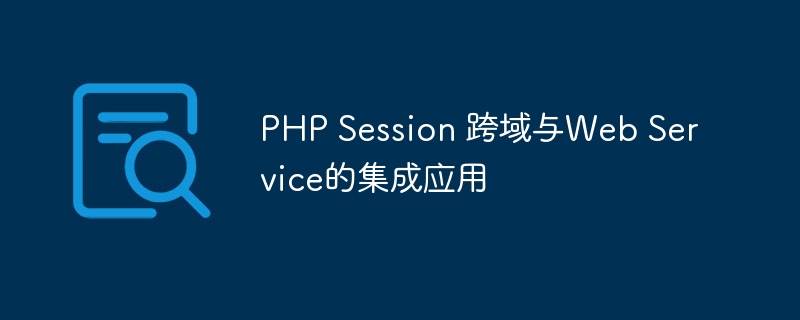Home >Backend Development >PHP Tutorial >Integrated application of PHP Session cross-domain and Web Service
Integrated application of PHP Session cross-domain and Web Service
- PHPzOriginal
- 2023-10-12 08:47:001386browse

PHP Session Cross-domain Integrated Application with Web Service
In modern Web development, Session management and cross-domain requests are very important issues. At the same time, it is becoming more and more common to use Web Services to integrate with other applications. This article will introduce how to implement Session cross-domain processing in PHP, and combine it with Web Service to implement a practical application example.
1. Session cross-domain processing
Cross-domain request means that when the browser sends a request to the target server, the source of the request is inconsistent with the domain name or port of the target. Due to the browser's same-origin policy, such cross-domain requests are prohibited. However, in actual development, we often need to share Session information between different domains. The following is a cross-domain Session processing method based on PHP:
-
Create an API interface on the target server to receive requests from other domains and process Session information.
// target_server.php session_start(); if ($_SERVER['REQUEST_METHOD'] === 'POST') { // 对于POST请求,验证来源域名是否合法 $origin = $_SERVER['HTTP_ORIGIN']; if (is_valid_domain($origin)) { header("Access-Control-Allow-Origin: $origin"); header("Access-Control-Allow-Credentials: true"); header('Content-Type: application/json'); // 处理Session信息 echo json_encode($_SESSION); } else { header('HTTP/1.1 403 Forbidden'); exit(); } } -
In the domain where the request is initiated, add corresponding logic to send cross-domain requests with Session information.
// client.php session_start(); // 设置目标服务器的URL $target_url = 'https://target_server.com/api/target_server.php'; // 发起跨域请求 $response = send_cross_domain_request($target_url); // 处理目标服务器返回的Session信息 $_SESSION = json_decode($response, true);
Through this method, we can share Session information between different domains and implement cross-domain requests.
2. Integrated application of Web Service
Web Service is a software system that communicates through the Web protocol and can provide cross-platform and cross-language service calls. PHP also supports the use of Web Services to integrate with other applications. The following is an example of Web Service integration based on PHP:
-
Deploy a Web Service on the target server and provide a service interface.
// api.php class MyWebService { public function hello($name) { return "Hello, $name!"; } } $server = new SoapServer(null, array('uri' => 'https://target_server.com/api/api.php')); $server->setClass('MyWebService'); $server->handle(); -
On the client, use PHP's SoapClient class to call the Web Service of the target server.
// client.php $wsdl = 'https://target_server.com/api/api.php?wsdl'; $options = array( 'uri' => 'https://client.com', 'location' => $wsdl, 'login' => 'username', 'password' => 'password' ); $client = new SoapClient($wsdl, $options); $response = $client->hello('John'); echo $response; // 输出:Hello, John!
In this way, we can integrate with other applications and call the Web Service provided by them.
To sum up, this article introduces how to perform Session cross-domain processing in PHP and combine it with Web Service to achieve integration with other applications. Through these methods, we can share Session information between different domains more flexibly and implement various application requirements.
The above is the detailed content of Integrated application of PHP Session cross-domain and Web Service. For more information, please follow other related articles on the PHP Chinese website!

